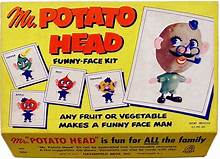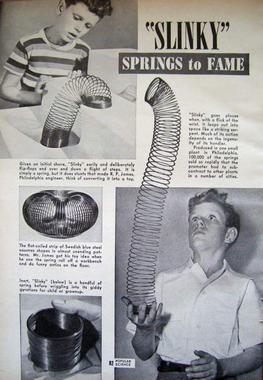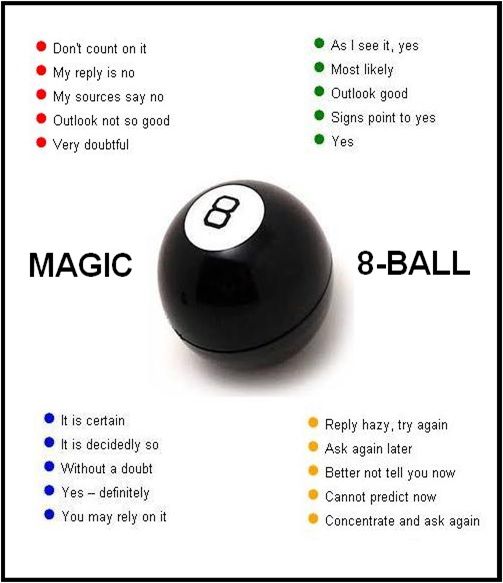
Brooklyn inventor and designer George Lerner came up with a revolutionary idea in 1949: a toy that children could design themselves. It came as a set of plastic body parts—noses, mouths, eyes—and accessories—hats, eyeglasses, a pipe—that were attached to pins. Children could decorate a potato or other vegetable with the pieces. During World War II, the U.S. had suffered through food rationing and using a potato as a toy seemed like a waste. Lerner shopped his toy idea around for a year but no takers. Instead, Lerner sold his idea to a cereal company for $5,000 and they would distribute the plastic parts as prizes in cereal.
In 1951, the Hassenfeld Brothers company (Herman and Henry Hassenfeld) met George Lerner and saw the potential for his toy. They paid the cereal company to stop production, buying the rights to Mr. Potato Head for $7,000 with Lerner getting $500 in advance and 5 percent royalties for every set sold.

- The first TV ad aimed diectly at children was the ad The Hassenfeld Brothers (later changed to Hasbro) created for Mr. Potato Head. It premiered on April 30, 1952.
- Who did the first voiceover for Potato Head in the first Toy Story movie?
The moody, crabby toy based on the famous Mr. Potato Head toy was voiced by Don Rickles.
Richard James, the founder of James Spring & Wire Company, invented the precompressed helical spring toy in 1943 while serving as a naval engineer at the William Cramp & Sons shipyards in Philadelphia. James, a mechanical engineer, accidentally knocked a spring off of a shelf and watched it ‘walk’ down a series of books, to a tabletop, and then to the floor where it neatly coiled itself. Making 400 units (wife Betty came up with the name Slinky) with a five hundred dollar loan they founded a company to mass-produce their creation. Slinky was not an immediate hit until James and Betty were granted permission to set up an inclined plane in the toy section of Gimbels Department Store in Philadelphia. They sold 400 units in an 1 1/2 hours for $1.00 each.

- Slinky is the Official State Toy of Pennsylvania.
- Each Slinky is made from 80 feet of wire which folds up in 10 seconds.
- Richard left the company in 1960 and Betty, then a single mother of 6, took it over. She stayed at the helm for 38 years.
- Because the metal properties of the Slinky resonates between 7 and 8 MHz, during the Vietnam War, American soldiers used it as an antenna.

His mother was a fortune teller that inspired an item sold as a paperweight that is now sold by Mattel in the millions. What popular toy is this? Albert C. Carter was the son of a Cincinnati clairvoyant. As his mother Mary’s popularity as a medium increased, so too, did Albert’s interest in her work. In particular, he was fascinated by one of her fortune-telling inventions, the Psycho-Slate. It consisted of a small chalkboard that could be placed inside of a sealed container. Mary would close the lid of the container and ask a question aloud to the “other world.” The room would fill with the sounds of chalk scribbling across the board and Mary would then open the container to reveal the answer. No one knows how she achieved the results, but Albert was inspired to create his own version of the Psycho-Slate.
Carter completed the device that he would call the Syco-Seer in 1944 and presented the prototype to local store owner, Max Levinson. Levinson expressed an interest in working with Carter to mass-produce the Syco-Seer with brother-in-law, Abe Bookman. Bookman was a graduate of the Ohio Mechanics Institute. Carter and Levinson turned to Bookman to handle the logistics of producing the Syco-Seer. They formed a novelty company, Alabe Crafts, Inc. in 1946. Under Bookman’s guidance, Alabe Crafts produced and marketed the Syco-Seer as a “Miracle Home Fortune-Teller” then another redesign and rebrand as “The Pocket Fortune Teller”.

In 1948, Bookman opted for yet another redesign but needed a marketing plan. He placed the Syco-Slate tube inside a crystal ball. This got the attention of Brunswick Billiards who were looking for a fun giveaway to promote their company; hence the reason for the 8 ball design. Once Bookman’s contract with Brunswick was fulfilled he chose to keep the design.
- Carter had applied for a patent for his “Liquid Filled Dice Agitator” in 1944, but didn’t live to see it granted. Luckily for Alabe Crafts, Carter had shared the patent assignment credit with Bookman and Levinson.
- Bookman originally marketed the Magic 8 Ball as a paperweight. It wasn’t until he noticed the Magic 8 Ball’’s popularity among children that re-marketed the product as a toy.
The internet has it’s own version of the Magic 8 Ball to ask online at https://askmagic8ball.com/
Resources:
https://www.thoughtco.com/history-of-mr-potato-head
https://en.wikipedia.org/wiki/Mr._Potato_Head#/media/File:Mr_Potato_Head_1952.jpg
https://en.wikipedia.org/wiki/Mr._Potato_Head
https://www.mentalfloss.com/article/67702
https://southfloridareporter.com/slinky-was-invented-by-accident
All those inventions from just across the river in Philadelphia! I don’t know how I made it to this far without ever owning a Mr. Potato Head.😊